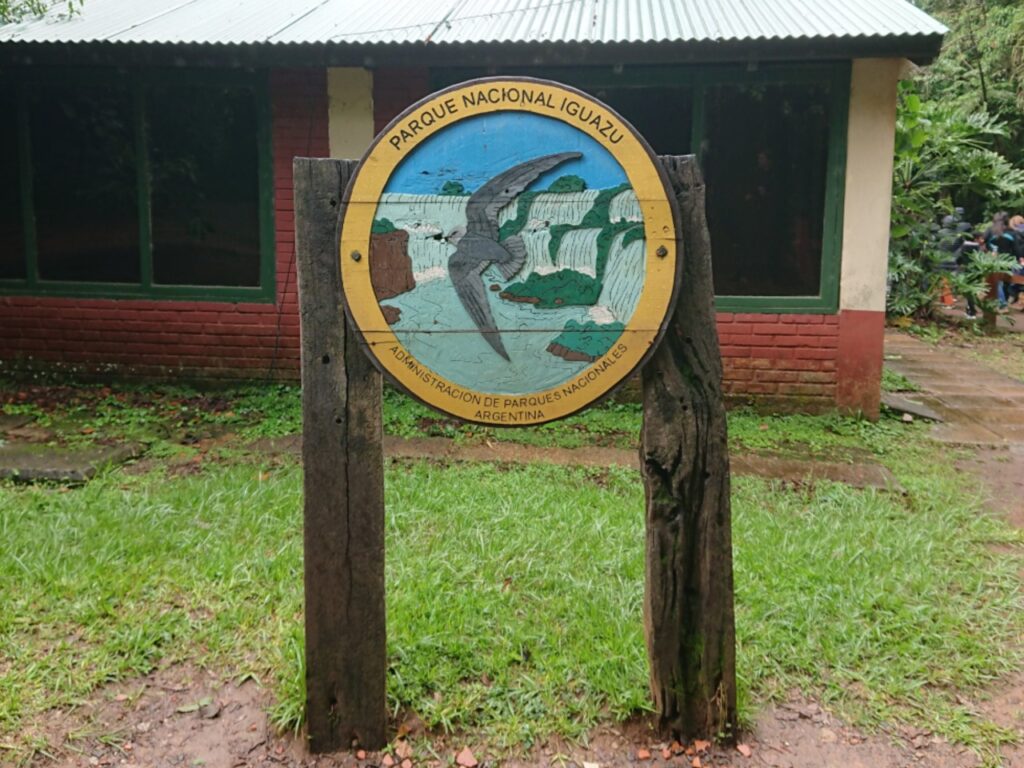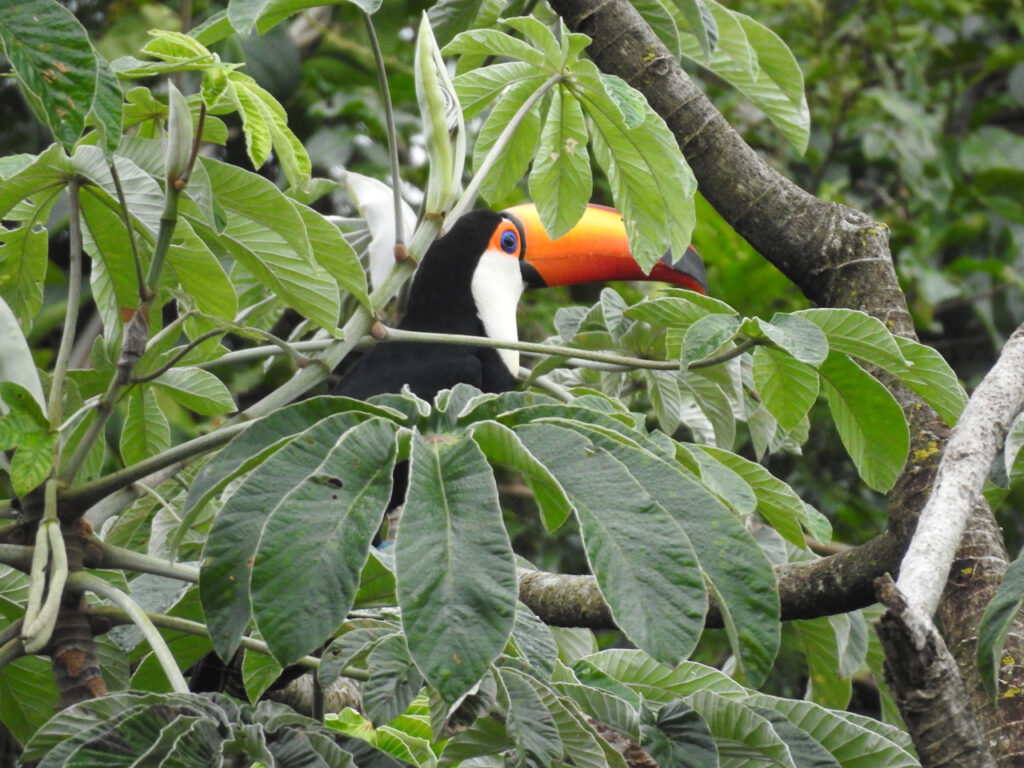This post is also available in: Dansk
The bird in the national park’s logo
There was plenty of water, but where were the Swifts? It was late May and we were at the famous Iguazu Falls in Iguazu National Park. The swifts we were looking for were the Great Dusky Swift – the bird in the national park’s logo.
The remarkable thing about the Great Dusky Swift is that they roost and breeds at waterfalls and the nests are placed adjacent to – or even behind – the rushing water of the waterfalls! That is clever because then the waterfalls act as a protective wall against predators.
With its numerous waterfalls and the surrounding rainforest, the Iguazu Falls are a perfect area for the species, which also houses a large population.
Read more about the Great Dusky Swift and Iguazú National Park in the fact box.

Sendero Macuco
We had spent all morning in the national park watching birds on the Macuco trail. We were lucky and got to see a flock of Spot-winged Wood-Quail crossing the trail in front of us. Along the way, there were tanagers and manakins, among others Band-tailed Manakin just to name one of the birds.
There were many birds and quiet and peaceful. On the Macuco trail, tourists do not come. Well, we only met a few local tourists. And that’s probably because that – besides a few small waterfalls – you can’t see the many impressive waterfalls, because you’re inside the rainforest.
Later in the day we would of course also see and experience the waterfalls and their most interesting residents – Great Dusky Swift.

An inferno of rushing water
It was wet at the Devil’s Throat – the largest and most impressive of the 275 waterfalls that make up the Iguazu Falls. It was an inferno of water and the noise of the rushing water was very loud. The water flow was huge and with a force that a mist of water droplets hung over the Devil’s Throat, which could be seen from a long distance. And not only that, some rain showers enhanced the experience of water and more water.
But there were no swifts to see – neither in the air nor on the cliffs, which we patiently scanned with our binoculars. It was not an easy task. Not only because of the fog but also because the space on the viewing platform was packed with people – tourists trying to get the perfect selfie in front of the Devil’s Throat.
We went down to the “Lower Walk” where you can see the waterfalls Dos Hermanas, Ramirez, Chico and the large wall of water at the Bosseti waterfalls. At one of the waterfalls, there was a sign informing about the exciting swifts living at the waterfalls. But we couldn’t find any here either!
On the other hand, there were probably more people on this path than up at the Devil’s Throat. Even though it was not high season, it felt a bit like we had hit the tourist route again (read about when we hit the tourist route in Peru in Desert racing, mysterious lines and a summer residence – we took the tourist route).

The article continues below this Advertisement
One more try
In early June we again visited the Iguazu Falls to make one more try to see more Great Dusky Swift.
We arrived at one o’clock and did not leave the park until it closed. We paid the entrance – which you get at half price on the second visit – and hurried to the railroad and drove the small train directly up to the stop at the Devil’s Throat.
The weather was significantly better than last time, but we still couldn’t find any swifts. We went down to the Lower Walk, but we didn’t see any swifts there either. Could it be due to the good weather? Maybe the swifts had flown farther away, seeking food over other parts of the national park.


As they spend the night in flocks ‘hanging’ on the cliffs, they had to return at the end of the day. At this point, we didn’t really think we should see any swifts – but we hoped that a single or two would show up around sunset.
The number of tourists was decreasing. The sun was setting and it wasn’t long before it was getting dark. We were now on the Upper Walk where we had not been before. But there was still no sight of something that looked just a little like an incoming swift.

The bird “Not to be missed”
Now the reader expects the next sentence will begin with the words: “Suddenly, out of the blue …”. But no, there were simply no swifts around, and it’s not because we have overlooked any – we’re pretty sure… they were gone!
It had seemed promising when you in the field guide Aves Argentina and Uruguay – that’s the one we had – can read about Great Dusky Swift: ”Not to be missed at Iguazú Falls”!
But had we already seen Great Dusky Swift?
The day before our first visit to Iguazu Falls, we were birding on a small stretch of Ruta 101, a dirt road that runs through the national park. A park guard had hesitated to allow us to drive into the road due to road conditions. They were not good, to say the least. Because of the recent days of rain, the road was slippery and it was like driving on soap!
But during the short trip, we briefly saw a flock of 10 – 12 swifts. They passed low over the forest, but the light was dim and you could not see colors on them. I got a couple of photos of one of the swifts where you see the shape of the bird – and maybe it was actually Great Dusky Swift…


Factbox
Great Dusky Swift (Cypseloides senex)
Taxonomically, the Great Dusky Swift belongs to the Swift family (Apodidae).
Swifts area are small to medium-sized birds adapted to life in the air. They have long, narrow wings and short, thin legs, but strong toes with sharp claws. The plumage is generally drab and brownish.
Great Dusky Swifts is a large swift (18 cm; 60-98 g.) with square or slightly rounded tail. Long broad wings and bulky body. The plumage is brown with a paler head (the front may appear almost white) and slightly paler rump. Juvenile birds have relatively pale median primary coverts.
Distribution: Central and Southern Brazil, Eastern Paraguay, and Northeast Argentina.
Breeds and roost around waterfalls, seeking foods during the day over nearby habitats.
Colonial, nests are placed on ledges adjacent to or behind waterfalls, often in direct sunlight.
Not globally threatened. Generally common, locally abundant, but scarce to uncommon in Paraguay.
Sources
- Chantler, P. & Boesman, P. (2019). Great Dusky Swift (Cypseloides senex). In: del Hoyo, J., Elliott, A., Sargatal, J., Christie, D.A. & de Juana, E. (eds.). Handbook of the Birds of the World Alive. Lynx Edicions, Barcelona. (retrieved from https://www.hbw.com/node/55259 on 21 December 2019).
- Chantler, P. (2019). Swifts (Apodidae). In: del Hoyo, J., Elliott, A., Sargatal, J., Christie, D.A. & de Juana, E. (eds.). Handbook of the Birds of the World Alive. Lynx Edicions, Barcelona. (retrieved from https://www.hbw.com/node/52266 on 21 December 2019).
Iguazu National Park
Iguazú National Park is located by the city of Puerto Iguazú, in the province of Misiones in northeastern Argentina. The national park covers an area of 67,620 ha. of Paraná-Paraíba forest, which is an ecological region of the Atlantic Forest.
Iguazu National Park is a World Heritage by Unesco, designated in1984. In addition, Iguazu waterfalls have also been designated as one of the world’s 7 natural wonders.
The river Iguazu, which means large water in Guaraní, flows into Paraná and flows at a width of 1,500 meters between islands and islets into a lava gorge formed 120 million years ago.
The area was declared a National Park on October 9, 1934.
All photos and video © Bente Steffensen & Uffe Damm Andersen, unless otherwise stated.

